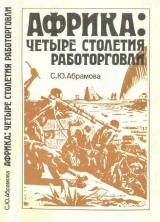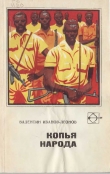
Текст книги "Африка: четыре столетия работорговли"
Автор книги: Светлана Абрамова
Жанр:
История
сообщить о нарушении
Текущая страница: 25 (всего у книги 26 страниц)
382. Klein H. S. The Middle Passage. Comparative Studies in the Atlantic Slave Trade. Princeton, 1978.
383. Klein М. A. Slavery, the Slave Trade and Legitimate Commerce in Late Nineteenth-Century Africa. – Etudes d'histoire africaine. II. P. – L., 1971.
384. Kuczynski R. Population Movements. Oxf., 1936.
385. La Ronciere Ch. de. Negres et negriers. P., 1933.
386. Lascelles E. Granville Sharp and the Freedom of Slaves in England. L.t 1928
387. Lascelles E. The Life of Ch. J. Fox. L., 1936.
388. Latimer J. Annales of the Bristol in the XVII Century. Bristol, 1900.
389. Liverpool, the African Slave Trade, and Abolition. Liverpool, 1976 (Historic. Society of Lancashire and Cheshire. Occasional Series, vol. 2).
390. Lloyd С The Navy and the Slave Trade. The Suppression of the African Slave Trade in the 19-th Century. L., 1949.
391. Lovejoy P. E. Transformations in Slavery. A History of Slavery in Africa. Cambridge, 1983.
392. Luna L. О negro na luta contra a escravidao. Rio de Janeiro, 1968.
393. McCloy Sh. The Negro in France. Kentucky, 1961.
394. Macinnes С England and Slavery. Bristol, 1934.
395. Mackenzie-Grieve A. The Last Years of the English Slave Trade, Liverpool, J 750–1807. L., 1941.
396. Mannix D. P. and Cowley M. Black Cargoes. A History of the Atlantic Slave Trade, 1518–1865. N. Y., 1962.
397. Mathieson W. L. British Slave Emancipation, 1838–1849. N. Y., 1967.
398. Mathieson W. L. British Slavery and its Abolition. L., 1926.
399. Mathieson W. L. British Slavery and its Abolition, 1823–1838. N. Y., 1967.
400. Mathieson W. L. Great Brftain and the Slave Trade, 1839–1865. N. Y., 1967.
401. Mauro F. Le Portugal et l'Atlantique au XVIIe siecle. 1570–1670. Etude economique. P., 1960.
402. Mauro F. Des Produits et des Hommes. Essais hist, latinoamer. XVI – XXe siècles. Paris – La Haye, 1972.
403. Memoranda Respecting the French Slave Trade in 1820. L., 1820.
404. Metral A. Les Esclaves. T. 1–2. P., 1836.
405. Miers S. Britain and the Ending of the Slave Trade. N. Y., 1975. -
406. Morton S. Y. The Crania Americana. A Comparative View of the Skulls of Various Aboriginal Nations of North and South America. Philadelphia, 1839.
407. Mottram R. H. Buxton the Liberator. L., 19 —.
408. Murray D. R. Odious Commerce Britain, Spain and the Abolition of the Cuban Slave Trade. Cambridge, 1980.
409. Murray D. R. Statistics of the Slave Trade to Cuba, 1790–1867. – Journal of Latin American Studies. London – New York, 1971, vol. 3. с 3.
410. Nardin J.-C. Encore des chiffres: la traite negriere Franchise pendant la premiere moitie du XVIII siecle. – Revue Franchise d'histoire d'Outremer. P., 1970, t. 57, № 209.
411. Newbury С W. British Policy Towards West Africa. Select Documents,: 1786–1874. Oxf., 1965.
412. New England Merchants in Africa. A History Through Documents 1802–1865. Boston, 1965.
413. Nineteenth-Century Africa. L“ 1968.
414. Negro Year Book. An Encyclopaedia of the Negro, 1937–1938. Alabama, 1937.
415. Nott J. Types of Mankind, or Ethnological Researches. Philadelphia, 1854.
416. Nwulia M. Britain and Slavery in East Africa. Wash., 1975.
417. Nwulia M. The History of Slavery in Mauritius and the Seychelles. 1810–1875. Rutherford – London, 1981.
418. Ortiz F. La africania de la musica folclorica cubana. La Habana, 1965.
419. Ortiz F. Glosario de Afronegrismos. La Habana, 1924.
420. Osae T. A. Short History of West Africa. A. D. 1000 to the Present. N. Y., 1973.
421. Osei G. K. Eupore's Gift to Africa. L., 1968.
422. Owen D. J: The Origin and Development of the Ports of the United Kingdom. L., 1048.
423. Palacios Placiado J. La trata de negros por Cartagena de Indias. Tunja, 1973.
424. Perez de la Riva J.? Cuantos africanos fueron traidos a Cuba? La Habana, 1977.
425. Peytrand L. L'esclavage aux Antilles franchises avant 1789. P., 1897.
426. Pitman F. W. The Development of the British West-Indies. 1700–1763. New Haven, 1917.
427. Portugal Ortiz M. La esclavitud negra en las epocas colonial у nacional de Bolivia. La Paz, 1978.
428. Postma J. The Dimension of the Dutch Slave Trade From Western Africa. – The Journal of African History. L., 1972, vol. 3, № 2.
429. Putney M. The Slave Trade in French Diplomacy From 1814 to 1815. – Journal of Negro History. Wash., 1975, vol. 60, № 3.
430. Race and Slavery in the Western Hemisphere: Quantative Studies. Princeton, 1975.
431. Racial Thought in America. Vol. I. Amherst, 1969.
432. Rawley J. A. The Transatlantic Slave Trade. New York – London, 1981.
433. Reindorf С.С. History of the Gold Coast and Asante, Based on Traditions and Historical Facts, Comprising a Period of More Than three Centuries From About 1500 to 1860. Basel, 1895.
434. Rinchon D. Les armements negriers au XVII siecle. D'apres la correspondence et la comptabilite des armateurs et des capitaines nantais. Bruxelles, 1956.
435. Rinchon D. Le trafic negrier d'apres les livres de commerce du capitaine gantois Pierre-Ignace-Lievin von Alstein. L'Organisation commerciale de la traite des noire. T. I. Bruxelles – Paris, 1938.
436. Rinchon D. La traite et l'esclavage des Congolais par les europeens. Histoi-re de la deportation de 13.500.000 Noirs en Amerique. Bruxelles, 1929.
437. Rodney W. How Europe Underdeveloped Africa. L.-Dar-es-Salaam, 1974.
438. Rodney W. Upper Guinea and the Significanse of the Origins of Africans Enslaved in the New World. – Journal of Negro History. Wash., 1969, t. X, № 4.
439. Rodriguez J. H. The Influence of Africa on Brazil and of Brazil on Africa. – The Journal of African History. L., 1962, vol. III, № 1.
440. Rogers J. A. Africa's Gift to America. The Afro-American in the Making and Saving of the United States. N. Y., 1961.
441. Ross D. A. The Career of Domingo Martinez in the Bight of Benin, 1833–1864. – The Journal of African History. L., 1965, vol. VI, № 6.
442. Saco J. A. Historia de la esclavitud de la raza africana en el nuevo mundo у en especial en los paises americo – hispanos. T. 1–4. Habana,,1938 (Coleccion de libras cubanos. Vol. 37–40).
443. Sanderson F. E. Liverpool and the Slave Trade: a Guide to Sources. Bibliographical Essay. – Transactions of the Historic. Society of Lancashire and Cheshire. Vol. 134. Liverpool, 1972.
444. Satineau M. Schoelcher. Heros de Tabolition de l'esclavage dans les possessions franchises. P., 1948.
445. Saunders A. C. A Social History of Black Slaves and Freedmen in Portugal 1441–1555. Cambridge, 1982.
446. Scelle G. La traite negriere aux Indes de Castille. Contrats et traites d'Assiento. P., 1906.
447. Schofield M. Shoes and Ships and Sealing Wax: Eighteenth – Century Lancashire Exports to the Colonies. – Transactions of the Historic. Society of Lancashire and Cheshire. Vol. 135. Liverpool, 1986.
448. Scofield J. Haiti – West Africa in the West Indies – National Geographical Magazine. L., 1961, vol. 119, № 2.
449. Seeber E. D. Antislavery Opinion in France During the Second Half of the Eighteenth Century. Baltimore, 1937 (The John Hopkins Studies in Romane Literatures and Languages, Extra Vol. 10).
450. Sheriff A. Slaves, Spices and Ivory in Zanzibar: Integration of an East African Commercial Empire into the World Economy. 1770–1873. L., 1987.
451. Silva Correa A. A. Historia de Angola. Vol. I. Lisboa, 1937.
452. Slaveowning Liverpool. – The Liverpool Review. Liverpool, 1884, 9, 16 and 23 Aug.
453. Slavery and British Society. 1776–1846. L., 1982.
454. Slavery in Africa. Madison – London, 1977.
455. Soulsby H. The Right of the Search and the Slave Trade in Anglo-American Relations, 1814–1862. Baltimore, 1933.
456. Stein R. L. The French Slave Trade in the Eighteenth Century. An Old Regime Business. Madison, 1979.
457. Suret-Canale J. De la traite negriere a l'aristocratie fonciere: les Walsh – Serrant. – De la traite a l'esclavage, t. 1. P., [б. г.].
458. Swann A. J. Fighting the Slave Hunters in Central Africa. A Record of Twenty-Six Years of Travel and Adventure Round the Great Lakes and the Overthrow of Tip-Pu-tib, Rumaliza and Other Great Slave Traders. L., 1969 (1-st. ed. 1910).
459. Toussaint A. Histoire de Tile Maurice. P., 1971.
460. Toussaint A. History of Mauritius. L., 1977.
461. Toussaint A. L'ocean indien au XVIIIe siecle. P., 1974.
462. The Trade of Bristol in the XVIII-th Century. – Bristol Record Society's Publications. Vol. XX. Bristol, 1957.
463. The Uncommon Market. Essays in the Economic History of the Atlantic Slave Trade. N. Y., 1979.
464. Vass W. K. The Bantu Speaking Heritage of the USA. Los Angeles, 1980.
465. Verger P. Flux et reflux de la traite des Negres entre golfe de Benin et Bahia de Todos os Santos du XVIII au XIX siecles. P., 1968.
466. Verger P. Nigeria, Brazil and Cuba. – Nigeria. Lagos, 1960 (Special Issue).
467. Verger P: Notes sur le Culte des Orisa et Vodun a Bahia la Baie de tous les Saints, au Bresil et a l'ancienne Cote des esclaves en Afrique. Dakar, 1957 (Memoires de 1'IFAN, № 51).
468. Verger P. Retour des «Brasiliens» au Golfe du Benin au XIXе siècle. – Etudes dahomeeens. Porto-Novo, 1966, № 8.
469. Vogt J. Portuguese Rule on the Gold Coast. 1469–1682. Athens, 1979.
470. Wallace J. A General and Descriptive History of Ancient and Present State of the Town of Liverpool. Liverpool, 1795.
471. Walvin J. The Black Presence. A Documentary History of the Negro in England, 1555–1860. L., 1971.
472. Ward W. E. F. The Royal Navy and the Slavers. The Suppression of the Atlantic Slave Trade. L., 1969.
473. White Ch. The Regular.Gradation of Man and in Different Animals and Vegetables. L., 1799.
474. Williams G. The History of the Liverpool Privateers and Letters of Marque, With an Account of the Liverpool Slave Trade. L., 1'897.
475. Wing J. van: Etudes Bakongo. Sociologie – Religion et Magie. Bruxelles, 1959.
476. Wismes A. de. Nantes et le temps des negriers. P., 1983.
477. Wright С Mauritius. Harrisburg, 1974.
478. Wylie К.С. The Slave Trade in Nineteenth Century. Temneland and the British Sphere of Influence. – African Studies Review. Michigan, 1973, vol. XVI, № 2.
479. Wyndham H. A. The Atlantic and Emancipation. L., 1937.
480. Wyndham H. A. The Atlantic and Slavery. L., 1935.
481. The Zambezi Expedition of David Livingstone. 1858–1863. Vol. 1–2. L., 1956.
482. look G. F. The Company of Royal Adventures Trading Into Africa. Lancaster, 1919.
* * *
SUMMARY
The book by S. Abramova traces the history of the transatlantic slave-trade from its beginning in the mid-15th century until its end in the latter half of the 19th century.
The Introduction indicates three major periods of the trade. The first began in the middle of the 15th century, when the Portuguese landed on the West African shores, and lasted until the mid-17th century. In the 15th century and in the first decade of the 16th century the slaves were being shipped to Europe; after 1510, with the emergence of Spanish colonies in the West Indies the trade was redirected to the New World. By the mid-17th century capitalism's advancement le The first two chapters, are concerned with the initial period of slave-trade. The Portuguese were followed, from the 16th* century on, by arrivals in West Africa from the Netherlands, England, and France. The European nations embarked on colonial expansion had by then already seized territories on the American mainland and in the West Indies. The colonies needed cheap labour, and that the Europeans found in Africa. Nowhere in Africa was the slave hunt more ruthless than in Congo and Angola, with the Portuguese concentrating exclusively on it there as Brazil was opened. The historians tell us that in a century between the 1580s and the 1680s no less than a million slaves were taken to the New World from Angola alone. Chapter Two is about East Africa in the 16th-18th centuries, the arrival there of Europeans, and their relations with the Swahili Arabs and indigenous Africans. All through that time the Arab slave-trade was far in excess of the Europeans', the book points out. In the 15th-18th centuries, the Arabs kept up the flow of slaves to the East dispite the European presence. The European-American slave-trade picked up in the 19th century, already after nearly all European and American, nations had abolished the practice. Chapter Three investigates the second period, when the “free” slave-trade was at its apex. The flourishing plantations and mines in the West Indies and both Americas supplying Europe with their products required ever more slave labour: the Barbados colonists alone were pressing for no less than 25,000 sla ves a year to meet their needs. The study shows the way the slave-trade affected Europe, specifically the slave-trading cities like Liverpool, Bristol, Nantes, and others. Chapter Four considers the systems of slave-trade in West Africa; it peruses a mine of documents like stories by slaveship crewmen, slavers, travellers, as well as parliamentary documents snowing the way the slave-trade was being kept up by sustained demand from Europe. We learn of how Africans were being enslaved through armed raids by Europeans on African villages, brazen hostage-taking, intertribe wars, special “slave-hunting” expeditions, kidnapping, selling people into slavery for crimes on charges often trumped up by the slavers. We further learn about the chief methods of slave purchases by European and American slave-traders. The chapter also describes the trade itself and the wares Africans demanded from the Europeans in exchange for the slaves. Chapter Five looks at the Africans' resistance to the trade, with episodes from numerous uprisings on the slaveships and unabating freedom stirrings on the New World plantations. By contrast the author offers evidence to prove that up to now there were no evidence of uprisings in Africa itself against the practice. Chapter Six explores moves to abolish the slave-trade, as well as the origins of racist attitudes towards Africans. Abolition campaigning peaked in the late 18th and the early 19th centuries in Europe and the newly founded US. The study cites the reasons for slave-trade abolishion specific to each particular slaver nation and tells about campaign leaders, among them A. Benezet, T. Clarkson, W. Wilberforce, Abbot Gregoir, and the others. It was also at that time, we learn, that racism came on the scene and subsequently evolved as a theory of Africans' “inferiority” to the Europeans, as slavers were casting about for an excuse for their practices. Chapter Seven is on the closing period of the slave-trade, the Contraband traffic from Africa. It probes the reasons for it and the abolition campaign mounted in Britain, featuring «mixed» commissions, anti-slavery blockades of the African coastline, and suchlike. It next surveys the abolition drive in major European nations and the US and reaction to it by the Russian press as indicative of Russian liberal thinking on the issue. Chapter Eight turns to the slave-trade in West and East Africa in the lQth century as contrasted with the free slave trade. Chapter Nine regards the latter decades of the transatlantic slave traffic, as it gradually gave way to colonial expansion on the continent. In summing up the author looks at the consequences of the slave-trade for the Africans and for the evolution of capitalism in Europe and America. The bibliography has documents from the Liverpool archives, the British state archives, press reports from the slave-trade days, an array of memoirs, works by abolitionists, etc. There are also illustrations, maps, and a geographical index.








